A pioneer overseas

Carole Husein, one of the first graduates of the new KPA Shelter Training & Enrichment course, is putting to good use everything that she learned in the course recently. Not only is she integrating lessons and tips from the Shelter course in her dog training business, School for Dogs, but she is making tremendous improvements in the lives of rescue dogs. Working through CyDRA (Cyprus Dogs Rehoming Association), an organization that supports private rescue kennels (Carole is the group's education and training coordinator), she oversees a private rescue kennel herself. Carole's volunteer and professional work is in Cyprus, a tiny ancient island in the Mediterranean, located south of Turkey, west of Syria and Lebanon, and northwest of Israel.
In Cyprus, many pets are neglected. They are rarely kept inside and suffer from boredom and loneliness. Many residents of Cyprus are brought up not to like dogs; many are afraid of dogs. Unfortunately, children continue to be taught that dogs are dirty and dangerous. To quote one of Carole's young students: "Grandma said we cannot have a dog because dogs rip your throat out." Other children have asked Carole if it is okay to hit or kick a dog like their parents do. Spaying and neutering procedures are not common. Pregnant dogs are often dumped on the road or over the fences of the many refuges in the area. It is not unusual to see dead dogs and cats on the roads, sometimes many at a time.
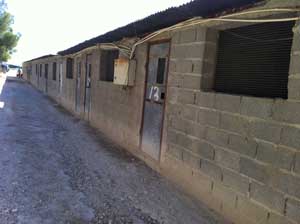
Dog shelter in Cyprus
Carole describes local conditions as horrific. "It is nothing to have dogs thrown over the fence [into the shelter] at night. Dogs come in after road accidents, shootings, and after having been caught in traps, beaten and abused, caged in tiny cages in the hills, fed rarely on bakery rubbish, starved, and ill."
The financial situation in Cyprus has made life even harder for the animals, according to Carole. Many more dogs are becoming homeless. People have lost jobs and businesses, and many have lost their life savings. If a family cannot feed the children, the priority is not going to be caring for the animals. Economic woes have also increased the hardships felt by rescue organizations, as donations are not offered as readily. Advertising the needs of rescue kennels provides the location of those kennels, and that leads to more dogs dumped over the fence at night! As a result, Carole and others find it difficult to reach the public and request assistance and aid.
Desperate to improve the situation for animals in Cyprus in any way that she could, Carole enrolled in the KPA Shelter Training & Enrichment course after hearing about it through the Karen Pryor Clicker Training newsletter. A longtime clicker trainer (a crossover trainer way back), Carole's clicker training mentor has been Kay Laurence. Relatively new to the rescue world, she was searching for as much information and education as she could find. In praising the Shelter Training & Enrichment course, Carole has many positive things to say about the ideas she accumulated for her work at the shelter, but also laughs about her clicker training refresher. She says, "The KPA course made me take stock of myself and my clicker skills. I had become slovenly and my training was somewhat dirty. The course encouraged me to pull my socks up!"
Bringing the lessons home
Carole's primary goal after completing the Shelter course was to make strategic changes to the shelter she managed. "The course played a big part in reinforcing my own belief that I can help a lot of dogs by training with a clicker, particularly in multi-dog kennels. It gave me so many ideas for environmental enrichment for the dogs (and cats) at the shelter."
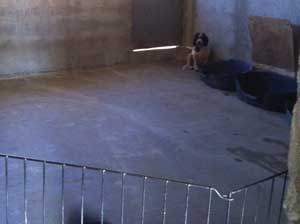
Typical concrete kennel
Existing shelter conditions were poor, for both the animals and for the hardy volunteer humans who were inclined to work with Carole. In an ongoing attempt to make the shelter cleaner and nicer, Carole has managed to tile most of one kennel with mismatched tiles that have been donated; the remaining kennels (20+) are comprised of raw concrete or dirt and stones. When Carole first began to work with her rescue shelter in Cyprus, there was nothing for the dogs at all. No social activity, no training, no enrichment—and no volunteers! In fact, the only humans the dogs saw were the cleaning boys who came in for half-days. Many dogs were scared of people at first. As time passed, Carole was joined by three trainers she had worked with at another facility, and through word of mouth gained a few more.
While the number of trainers fluctuates, there are six trainers at the rescue with Carole currently. "In Cyprus you find military personnel who stay a few years and then leave—just when they are becoming a really valuable resource!" With her eyes and ears always open for possible recruits, Carole advertises on the CyDRA website, and calls upon people she knows (and their friends!). The shelter has just welcomed its first teenaged volunteer, a result of recent outreach visits to schools. While finding and educating trainers is an ongoing problem, Carole says that "creating a united team has been easy because everyone is keen to learn what it takes to care for and train the dogs."
Each trainer is assigned one dog with issues to work with (under supervision) and another dog to train for trick tests. Carole supervises all training and behavior work; this responsibility is lessening as trainers begin to work independently. There is one trainer who is training to become Carole's assistant. All trainers (including Carole) are volunteers and are not paid at all.
Clicker trainers
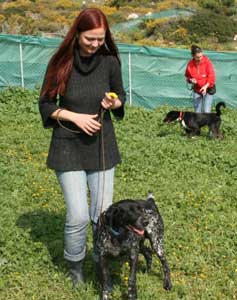
Corrina & Stina clicker training
Carole had already introduced clicker training to the training team before she completed the Shelter Training & Enrichment course. She wondered if her volunteers would take to using a clicker or if they would find it too difficult, but they have all embraced the philosophy. Introducing the clicker to her volunteer staff helped Carole grow as well. She says, "In my training school I ended up being more of a trainer who used a clicker. Not the same as a clicker trainer! Teaching clicker training to others helped me become the clicker trainer I wanted to be."
What Carole cites as a major benefit of the Shelter Training & Enrichment program is that she now has a course, one she has tried herself, that she can recommend to trainee trainers. Several of Carole's trainers are looking into shelter courses; one has already enrolled in the KPA Shelter Training & Enrichment course. Another volunteer is also eager to complete the KPA course, but has put that goal on hold for a short while. As Carole reports, "She has to get used to being a new Mum first!"
With help from the KPA course materials, instructors, and fellow graduates, as well as from other sources including friends in rescue work and trainers all around the globe, Carole has developed a leveled training program for her trainers.
Clicker basics for shelter students
As for helping to improve the lives of the shelter dogs themselves, Carole has found the clicker to be a wonderful training tool. Currently, she is working with several traumatized and under-socialized dogs and has seen change and growth in their behavior by using the clicker. "At times I also use a word as a marker, and have become very good at clicking with my mouth when my hands are otherwise engaged!"
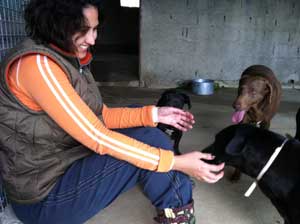
Dogs greet a shelter volunteer happily
Some dogs that would not come anywhere near the volunteers at first now greet them happily. Others continue to make progress toward that level of comfort. Carole says that a beginning training session could be as simple as sitting in a kennel clicking and treating anything and everything good. She has seen clicker training work for so many dogs. "It is the only way I would do it now. We give dogs the choice to approach and they eventually do."
The volunteer staff's ability to work with the dogs is hampered by the sheer number of rescued dogs. Despite that disadvantage, Carole and her volunteers have found that the dogs continue to respond very well even when they have not seen a trainer for a week or two. She explains further, "It took us five weeks to introduce the clicker to all of the dogs (then 90+ dogs). We run Clicker 1 and Clicker 2 sessions that are only about conditioning the clicker. Most of the dogs learn the idea that if they hear the click then there is a reward coming. Even after two weeks, most dogs retain the knowledge from those two sessions, or remember it as soon as they are reminded."
The next lessons are sit (don't jump) and touch. Some of the dogs already know those two behaviors, but new dogs seem to grasp the cues quickly enough. After these two behaviors that reinforce the click, the dogs move on to other basic behaviors and tricks. Carole's program uses luring, capturing, shaping, and mimicry to teach new behaviors.
Since it is too hot for the dogs to go out during high summer, volunteers traininside the kennels. They are able to do mat training, targeting, find it, tricks, and use interactive toys. Most of the shelter's kennels have large runs, so volunteers can include lead walking, recalls, retrieves, skateboards, hoops, boxes, and more in their training and enrichment lessons. The philosophy for the dogs is that nothing should be taken too seriously; it is more about fun and games. In the winter, trainers can work with the dogs more outside. The shelter does include expansive grounds, and each kennel gets a turn outside.
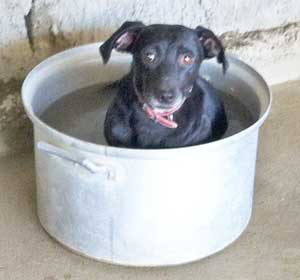
Enrichment, Cyprus style!
At the rescue shelter, there is a mixture of old and young dogs, along with dogs that will never get re-homed. Carole believes that they are all equally entitled to volunteer time. She and her staff work with them all, choosing something each can do. There are many anxious dogs at the shelter, and no veterinary behaviorist. Even when there is a clear need for medication because of behavior issues, the local vets know very little about behavior; their help is hit or miss.
Challenges
In addition to finding, maintaining, and training volunteers, and managing the logistics of training so many different dogs, there are other challenges to Carole's rescue work. Environmental enrichment, supplementing the basic training and exercise described above, is one area with which they struggle. Carole explains one part of the difficulty. "It is hard for us to leave items and articles inside the kennels because they are multi-dog kennels, holding from 2 to 6 dogs. When I first started, some kennels held up to 10 dogs. I have worked to persuade the shelter owner to reduce the number of dogs in each kennel, but would like to see fewer."
As a start, tricks and fun agility skills have been introduced to give both dogs and trainers a challenge and more focus. The shelter's first dogs are ready to be tested for various titles! Carole says she has received a great deal of assistance and advice from Leanne Falkingham, co-author of the KPA Shelter Training Enrichment course and the online instructor resource for students in the course. Information from other graduates of the shelter course and from the larger KPA community has also been invaluable.
With advice from Leanne and other Shelter course students, Carole has broader enrichment plans. With very little money available, training and enrichment items tend to be homemade (sharing and brainstorming inexpensive ideas with Shelter course community members has been extremely helpful!). Donations of garden agility equipment have come in to the rescue shelter, and kind builders have made stairs so dogs can practice going up and down. One builder is creating a see-saw and an A-frame for the dogs, and the shelter has been able to buy all of the kennels paddling pools. The new, uncovered training compound also has a pool (next fundraising goal: a cover for this area!).
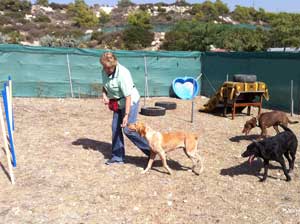
Group enrichment training
During the Shelter Training & Enrichment course, Carole heard from instructor Leanne Falkingham about a play-yard Leanne's friends have for their goats! Carole has shown volunteer builders plans for this goat yard, expressing her desire to have this wish-list item added to the dog runs at the shelter. When and if her dream comes true, Carole believes there is even more enrichment training that can be accomplished with this new goat-style equipment.
Outreach as a tool of change
The dog world in Cyprus is limited and rigidly defined, in Carole's view. The kennel club only encourages breeding for the show world. Another organization exists for hunters. In Carole's words, "The very rich, big businessmen, and politicians and judges who hunt are all involved so not a lot will change." Apart from conformation, there are no other competition sports. The lack of progressive organized groups in the field makes it hard to pass the word around about issues such as the need for neutering.
To combat some of these societal challenges, Carole supports organizations that try to improve animal welfare in Cyprus. She believes that education is the only answer to the problems in Cyprus. She and her colleagues are dedicated to the education tool.
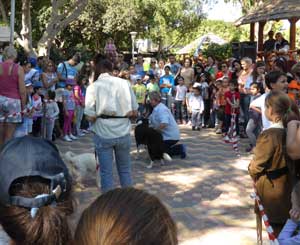
Dogs showing off their skills
at a Cyprus children's festival
One way they hope to make a difference is by giving presentations. Currently, Carole goes out on all presentations, but she is training small groups of trainers who can go out on their own, leaving Carole more time for future projects. Recently, Carole and others visited the Limassol Zoo where efforts to improve the lives of the animals there have been completed successfully. They were accompanied by Carole's dog and one of the rescue dogs in order to demonstrate how dogs can be fun to train, and to demonstrate positive ways to interact with dogs.
Carole and other volunteers are involved with the Be a Tree program, attending schools to explain ways to stay safe around dogs. To broaden the message, Carole and her group are in the process of translating all of the Be a Tree handouts into Greek. They also make Animal Care in the Community presentations to schools, designed to encourage older children to both help educate younger students and volunteer their valuable services to the animal welfare community. Cyprus schoolchildren can visit the shelter to learn about dogs and their needs, volunteer, and help dogs learn some social skills and fun, all while earning Duke of Edinburgh Awards and other international projects that are required by their schools.
Other education efforts include the Tales to Tails Therapy Dog program. Dogs visit schools where children have reading difficulties, other educational needs, or confidence issues. The children read to the dog without being judged or made to feel inadequate. This is a new program and the dogs and handlers are still being trained to participate. When the training is complete, organizations for the elderly and the handicapped are also interested in visits from the shelter dogs.
Carole is discussing the formation of a kids 'n dogs (maybe other pets, too) club in one of the schools where Be a Tree presentations are already being made. Club members would meet once a week or once every two weeks to learn how to care for and train their own dogs. Another future outreach effort with therapy dogs may be partnering dogs with young offenders who are incarcerated, to see if the youngsters in facilities can train and care for some of the shelter dogs. Of course, clicker training would be the training method of choice in this project.

Therapy dogs in training
Carole's overarching goal is to create an awareness in Cyprus that dogs can be great companions for all ages; dogs are loyal, intelligent, loving, and fun! With a little understanding and training, they can live in a family group happily and successfully. Dogs deserve quality of life, whether they are in a rescue center, a home, or even within the hunting fraternity. By bringing the need to respect and love dogs, all animals, to the forefront, Carole and her colleagues hope to change the lives of dogs and people as positively as possible. If in the future Carole could gather together as many trainers as possible to form a group that would spread clicker training and other positive training methods, and encourage organizations to work together in the best interest of animals, that would be a marvelous achievement, too!
Star shelter student
Carole's efforts at the rescue shelter she manages, as well as in her local and global communities, illustrate perfectly how the KPA Shelter Training & Enrichment course can have far-reaching, positive impact in training and create hope for the future. Implementing lessons from the shelter course, as well as tweaking generously shared input from the KPA learning community to make changes in the unique environment of Cyprus, Carole is making a measurable difference for dogs. She says, "All those years ago when I trained with Kay I never for a moment thought it would lead to what I now do! Am I exhausted? Of course! Is it worth it? Absolutely!"



Post new comment